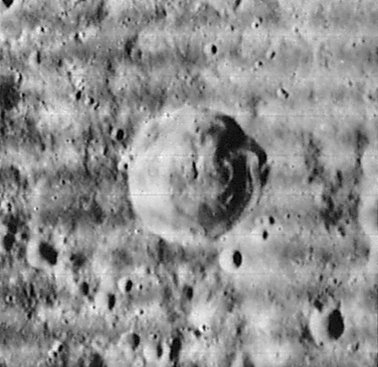Difference between revisions of "Tacitus"
| Line 14: | Line 14: | ||
<br /> | <br /> | ||
==Description: Elger== | ==Description: Elger== | ||
| − | ''([[IAU% | + | ''([[IAU%20directions|IAU Directions]])'' TACITUS.--A bright ring-plain, about 28 miles in diameter, a few miles W. of [[Catharina|Catherina]], with a lofty wall rising both on the W. and E. to more than 11,000 feet above the floor. Its continuity is broken on the N. by a gap occupied by a depression, and there is a conspicuous crater below the crest on the S.E. The central mountain is connected with the N. wall by a ridge, recalling the same arrangement within [[M%C3%A4dler|Mädler]]. A range of lofty hills, an offshoot of the [[Rupes%20Altai|Altai range]], extends from Tacitus towards [[Fermat|Fermat]].<br /> <br /> |
==Description: Wikipedia== | ==Description: Wikipedia== | ||
[http://en.wikipedia.org/wiki/Tacitus_(crater) Tacitus]<br /> <br /> | [http://en.wikipedia.org/wiki/Tacitus_(crater) Tacitus]<br /> <br /> | ||
==Additional Information== | ==Additional Information== | ||
| − | * Depth data from [[Kurt%20Fisher% | + | * Depth data from [[Kurt%20Fisher%20Crater%20Depths|Kurt Fisher database]] |
** Westfall, 2000: 2.84 km | ** Westfall, 2000: 2.84 km | ||
** Viscardy, 1985: 2.84 km | ** Viscardy, 1985: 2.84 km | ||
** Cherrington, 1969: 2.83 km | ** Cherrington, 1969: 2.83 km | ||
* Central peak height | * Central peak height | ||
| − | ** [[Sekiguchi%2C%201972|Sekiguchi, 1972]]: 0.5 km "Very long dyke parallel to the meridian line" <span class="membersnap">- [http://www.wikispaces.com/user/view/fatastronomer [[Image: | + | ** [[Sekiguchi%2C%201972|Sekiguchi, 1972]]: 0.5 km "Very long dyke parallel to the meridian line" <span class="membersnap">- [http://www.wikispaces.com/user/view/fatastronomer [[Image:Fatastronomer-lg.jpg|16px|fatastronomer]]] [http://www.wikispaces.com/user/view/fatastronomer fatastronomer]</span> |
* '''Tacitus D''' central peak height | * '''Tacitus D''' central peak height | ||
| − | ** [[Sekiguchi%2C%201972|Sekiguchi, 1972]]: 0.5 km "A mountain having a summit crater" <span class="membersnap">- [http://www.wikispaces.com/user/view/fatastronomer [[Image: | + | ** [[Sekiguchi%2C%201972|Sekiguchi, 1972]]: 0.5 km "A mountain having a summit crater" <span class="membersnap">- [http://www.wikispaces.com/user/view/fatastronomer [[Image:Fatastronomer-lg.jpg|16px|fatastronomer]]] [http://www.wikispaces.com/user/view/fatastronomer fatastronomer]</span> |
* A bright "half ejectablanket" at 17°35' South/ 19°15' East (immediately south of '''Tacitus''') is noticeable during the days before, during, and after Full Moon. This ejectablanket looks like some sort of bright "arc". See LROC close-up''':''' http://bit.ly/2ChElPC<span class="membersnap">- DannyCaes <small>Jan 18, 2009</small></span> | * A bright "half ejectablanket" at 17°35' South/ 19°15' East (immediately south of '''Tacitus''') is noticeable during the days before, during, and after Full Moon. This ejectablanket looks like some sort of bright "arc". See LROC close-up''':''' http://bit.ly/2ChElPC<span class="membersnap">- DannyCaes <small>Jan 18, 2009</small></span> | ||
<br /> | <br /> | ||
Revision as of 02:19, 16 April 2018
Contents
Tacitus
|
Lat: 16.2°S, Long: 19.0°E, Diam: 39 km, Depth: 2.84 km, Rükl: 57 |
Images
LPOD Photo Gallery Lunar Orbiter Images Apollo Images
- Tacitus was also captured on several frames made by the southward looking mapping/metric Fairchild camera of Apollo 16, such as in frame AS16-M-0697, which shows the pronounced crater Tacitus slightly "above" the centre of the line which connects the frame's centre and the centre of the frame's left margin.
- Research: Danny Caes.
Maps
(LAC zone 96A2) LAC map Geologic map
Description
Description: Elger
(IAU Directions) TACITUS.--A bright ring-plain, about 28 miles in diameter, a few miles W. of Catherina, with a lofty wall rising both on the W. and E. to more than 11,000 feet above the floor. Its continuity is broken on the N. by a gap occupied by a depression, and there is a conspicuous crater below the crest on the S.E. The central mountain is connected with the N. wall by a ridge, recalling the same arrangement within Mädler. A range of lofty hills, an offshoot of the Altai range, extends from Tacitus towards Fermat.
Description: Wikipedia
Additional Information
- Depth data from Kurt Fisher database
- Westfall, 2000: 2.84 km
- Viscardy, 1985: 2.84 km
- Cherrington, 1969: 2.83 km
- Central peak height
- Sekiguchi, 1972: 0.5 km "Very long dyke parallel to the meridian line" - fatastronomer fatastronomer
- Tacitus D central peak height
- Sekiguchi, 1972: 0.5 km "A mountain having a summit crater" - fatastronomer fatastronomer
- A bright "half ejectablanket" at 17°35' South/ 19°15' East (immediately south of Tacitus) is noticeable during the days before, during, and after Full Moon. This ejectablanket looks like some sort of bright "arc". See LROC close-up: http://bit.ly/2ChElPC- DannyCaes Jan 18, 2009
Nomenclature
- According to the IAU Planetary Gazetteer, this feature is named for Cornelius Tacitus (ca. 56 – ca. 117), a senator and historian of the Roman Empire.
- As noted by Kuiper in Table III of his Photographic Lunar Atlas, the present name is actually a misspelling by Beer and Mädler of the name Tatius given by Riccioli. Riccioli had in mind a certain Achilles Tatius of the 4th century A.D., who he describes in his Chronology as a Bishop of Alexandria.
- This feature is Catalog number 3759 in Mary Blagg's Collated List, where the spelling Tacitus was used by all three authorities, and was adopted in that form in the original IAU nomenclature of Named Lunar Formations.
- Kuiper observed it would be too confusing to "correct" the spelling.
LPOD Articles
Bibliography
